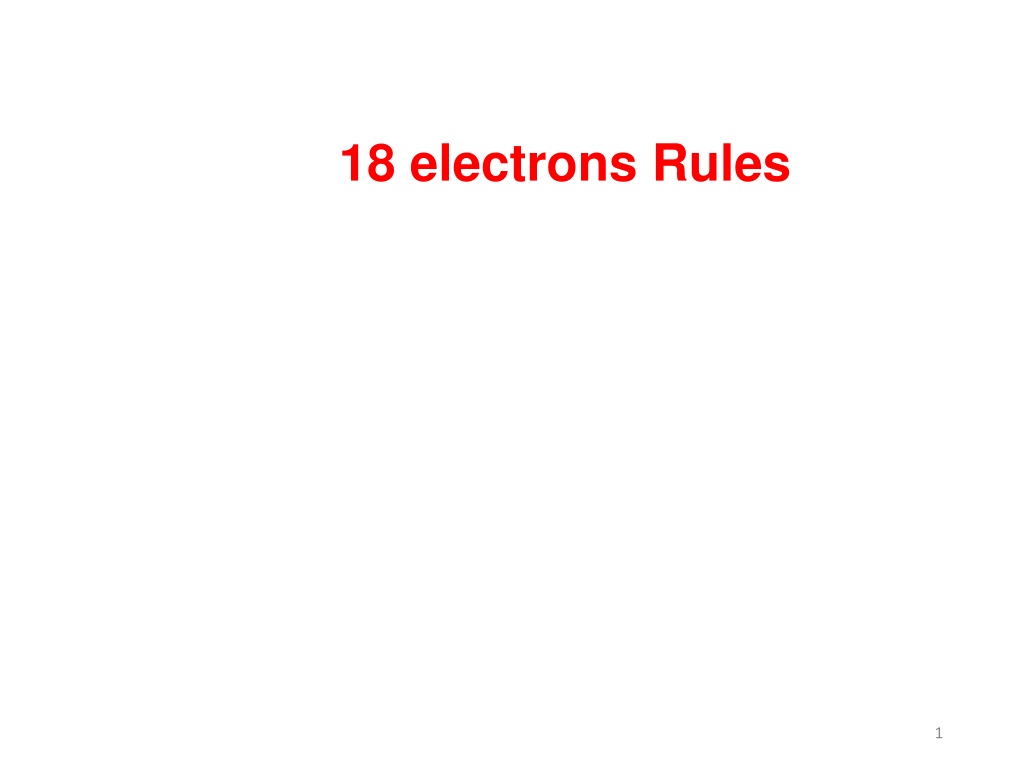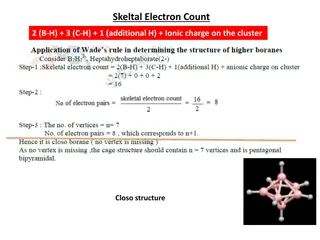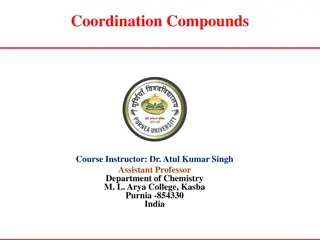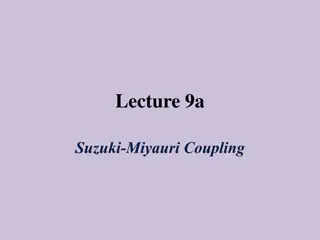Understanding the 18-Electron Rule in Transition Metal Organometallic Compounds
The 18-electron rule governs the stability of transition metal organometallic compounds by requiring the sum of metal d electrons and ligand-supplied electrons to be 18. This rule highlights the importance of electron count and ligand characteristics in forming stable complexes. Key concepts include coordination geometries, counting methods, and bond formation based on electron counts.
Download Presentation

Please find below an Image/Link to download the presentation.
The content on the website is provided AS IS for your information and personal use only. It may not be sold, licensed, or shared on other websites without obtaining consent from the author. Download presentation by click this link. If you encounter any issues during the download, it is possible that the publisher has removed the file from their server.
E N D
Presentation Transcript
18 electrons Rules The rule states that thermodynamically stable transition metal organometallic compounds are formed when the sum of the metal d electrons and the electrons conventionally considered as being supplied by the surrounding ligands equals 18. In general, the conditions favoring adherence to the 18-electron rule are, an electron rich metal (one that is in a low oxidation state) and ligands that are good -acceptors The hapto symbol, , with a numerical superscript, provides a topological description by indicating the connectivity between the ligand and the central atom. For example, if all the five carbon atoms of a cyclopentadienyl moiety are equidistant from a metal atom, we term it as 5 cyclopentadienyl Examples: 1-R, 1-Ar 2-C2R4 1-allyl, 3-allyl, 4-Cb, 5-Cp, 6-C6H6, 8-C8H8 2-C60, 5 -R5C60 2
Early Transition Metals 16e- and sub-16e- configurations are common Coordination geometries higher than 6 relatively common Middle Transition Metals 18e- configurations are common Late Transition Metals 16e- and sub-16e- configurations are common Coordination geometries of 5 and lower are common: d8= squareplanar Coordination geometries of 6 are common 5
Neutral atom method: Metal is taken as in zero oxidation state for counting purpose Oxidation state method: We first arrive at the oxidation state of the metal by considering the number of anionic ligands present and overall charge of the complex Suggestion: Focus on one counting method till you are confident 6
Determine the total valence electrons (TVE) in the entire molecule (that is, the number of valence electrons of the metal plus the number of electrons from each ligand and the charge); say, it is A. Subtract this number from n 18 where n is the number of metals in the complex, that is, (n 18) A; say, it is B. (a) B divided by 2 gives the total number of M M bonds in the complex. (b) A divided by n gives the number of electrons per metal. If the number of electrons is 18, it indicates that there is no M M bond; if it is 17 electrons, it indicates that there is 1 M M bond; if it is 16 electrons, it indicates that there are 2 M M bonds and so on. 7























